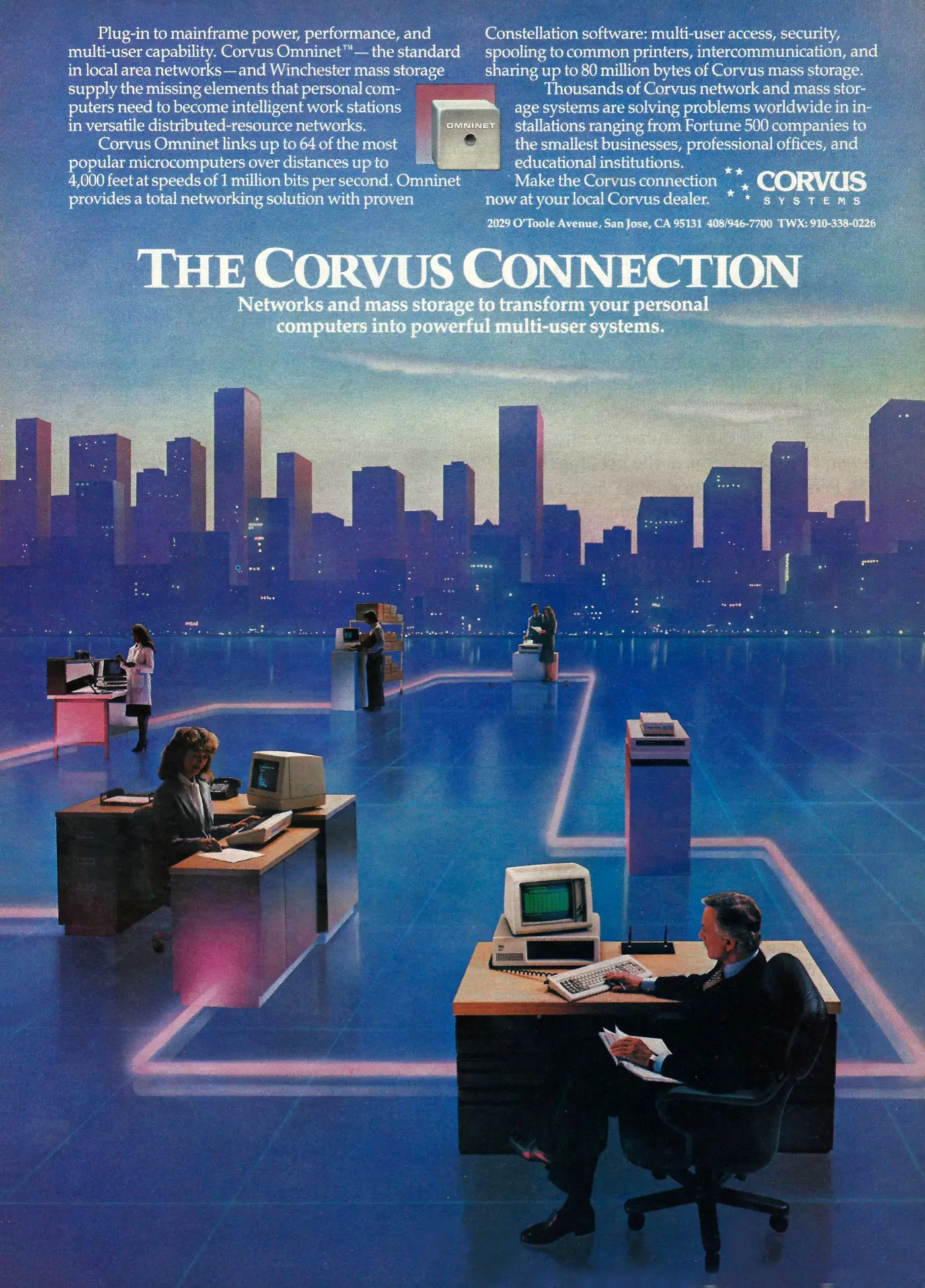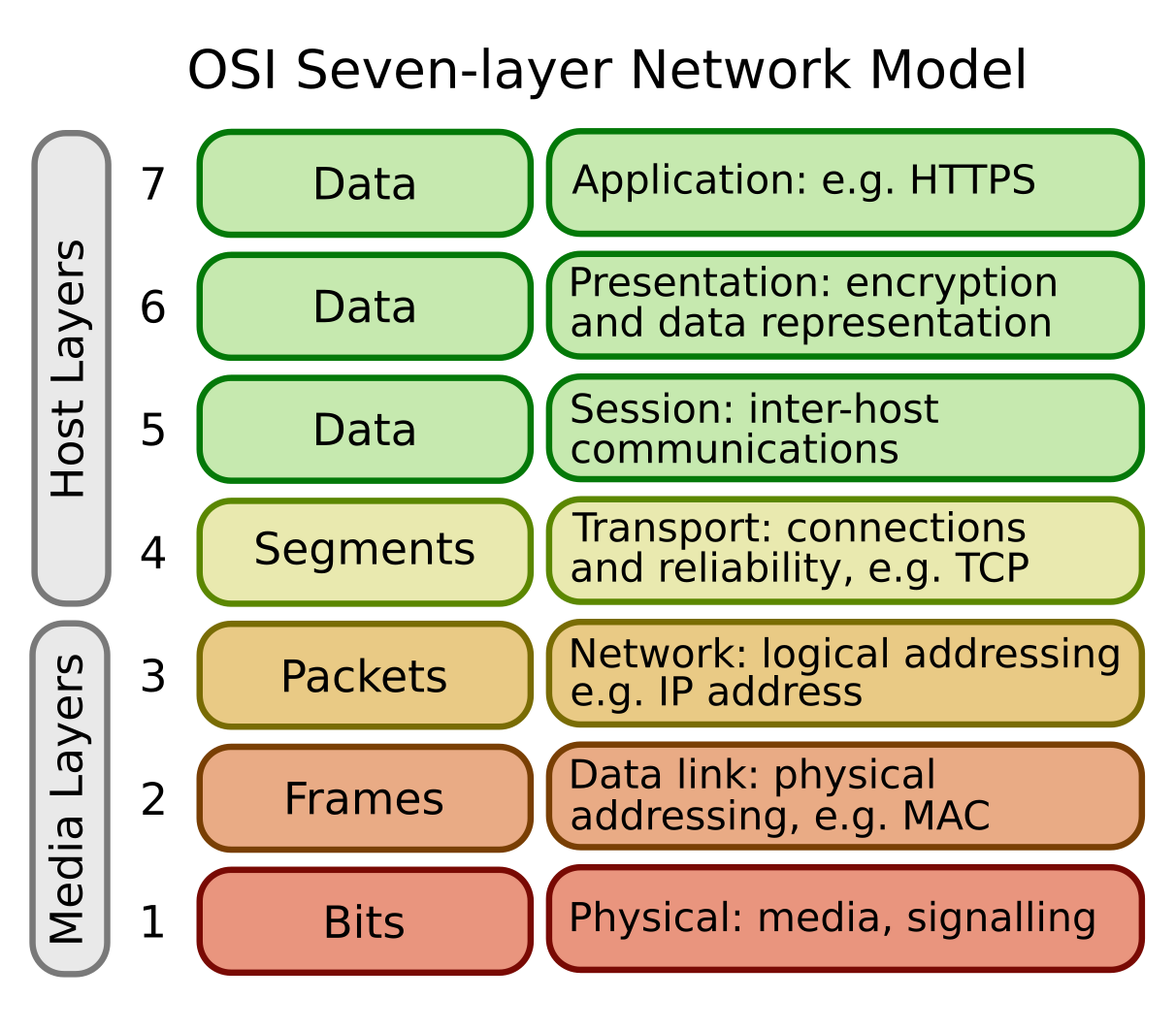Corvus Advert - May 1982
From Personal Computing

Omninet: The Corvus Connection
Corvus was founded in 1979 with a few million dollars of venture-capital seed money in order to build disk drives for Apple.
However, as disk drives were often more expensive than the computers they were attached too, the company decided that sharing disks over a network would make them more affordable.
Corvus soon switched its focus entirely to the networking market, and in 1980 pioneered networks based upon twisted-pair cable - a type of cable which was a bit like telephone wire and which was much cheaper and easier to deploy than the thick, inflexible coaxial cable prevalent at the time
Corvus formally launched its twisted-pair Omninet/1 local area networking (LAN) technology the following year[1]. It used the RS-422 standard - which could operate at up to 4,000 metres - and supported a data transfer rate of up to 1 megabit per second.

The OSI seven-layer network model, from media, like wires or radio, at layer 1, up to applications like HTTP or HTTPS at layer 7. © nosher.net 2025. This work is licensed under CC BY-SA 4.0. It is loosely based upon a work in Wikimedia Commons.
Unlike the Ethernet standard, which would eventually come to dominate LAN systems, it was only open at the lower four layers of the standard OSI "Seven Layer Model", which were essentially all the non-data layers.
It was properietary on the remaining three layers, and so suffered from vendor lock-in.
Despite that, it nevertheless became the first commercially-successful networking system, as it was about a third the price of equivalent networking systems such as Ethernet, which cost upwards of $1,000 per installation. It was reported by Infosec at the end of 1984 that three out of every five networked micros were connected to Corvus networks[2].
Johns Hopkins School of Medicine installed a small seven-node Omninet system - at a cost of $12,000, or about £35,300 in 2025 - as a test in May 1983, and published a paper with the results of using it for a year.
The conclusion noted how LAN systems would eventually lead to the death of multi-user systems for most situations when it stated:
"While an IBM-PC has less computing power than a traditional mini-computer, the very nature of the LAN provides an appearance of a multi-user environment. Also, as more persons sign on to the network, there is no degradation of response, as each workstation remains an independent unit. Actual delays as a result of contention for the network line are few as long read or write procedures are not a common event".
Author of the paper, R.S. Johanes MD concluded:
"The greatest drawback we see in Omninet is its closed architecture at the top ISO levels. This does lock the network user into Corvus Industries as the sole support for the network. To date, this has not proven a problem for us nor for the other Omninet users in the Hopkins environment. However, ability to access certain network resources, such as who is logged on at any time, is not available directly nor are sufficiently detailed manuals available to allow users to develop such low level support software. Omninet provides a reliable and inexpensive offering into small micro- computer based LAN's in the 16 bit marketplace. While not a open system, this drawback may be more of an issue in the 32 bit super-micro LAN's than it is in the 16 bit micro world[3]."
Corvus went through some financial difficulties during the mid 1980s, triggered by a move into non-IBM-compatible microcomputers, some poor acquisitions, and its lateness in recognising the threat of the IBM PC[4].
After exiting the computer business entirely in 1987, it continued for a while after re-focussing on its core network market.
Corvus ended up filing for bankruptcy protection under Chapter 11 in 1987, a move triggered partly by the increasing dominance of Ethernet, and seemed to fizzle out in the early 1990s whilst resisting a creditor-driven attempt to reorganise it[5].
Date created: 19 January 2024
Last updated: 05 November 2025
Hint: use left and right cursor keys to navigate between adverts.
Sources
Text and otherwise-uncredited photos © nosher.net 2025. Dollar/GBP conversions, where used, assume $1.50 to £1. "Now" prices are calculated dynamically using average RPI per year.

